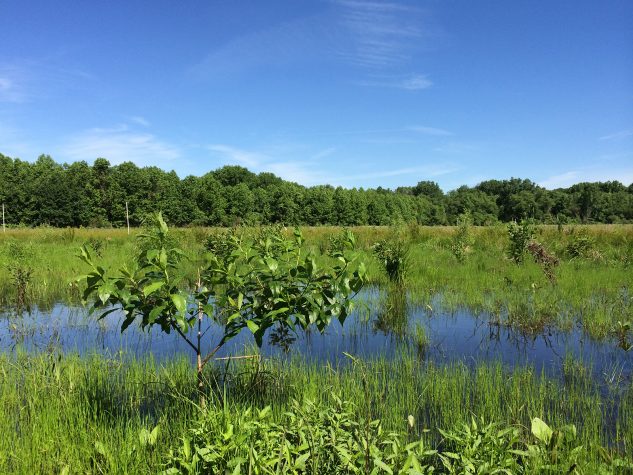by McKenzi Heger | November 26, 2019
Wetlands are one of the most productive ecosystems in the world and are often looked at in similar ways as rain forests and coral reefs. Their physical and chemical features (including climate, topology, and geology) are the deciding factors when it comes to which species inhabit the wetland.
Not only do they provide habitat for these species, but they also provide a large amount of food that helps attract them. The dead plant leaves and stems break down and create organic matter for insects and aquatic animals to feed on which, in turn, are food for the other fish, reptiles, amphibians, birds, and mammals in the area. With a majority of the animals using wetlands for a portion (or all) of their life, this cycle continues and ensures the wetlands remain healthy and thriving.
Other than being known as nature’s “biological supermarket” and acting as a great source of food for wildlife, wetlands offer other benefits to our environment, including:

1. Creating a Habitat for Fish, Wildlife & Plants: While some animals use wetlands on a more seasonal basis, others use it for the entire duration of their life. There are also cases of species using wetlands for wintering, nesting, or raising their young, including the Black Duck which has used coastal wetlands in the Chesapeake Bay region for their wintering purposes.
2. Improving Water Quality & Hydrology: Wetlands are great influencers when it comes to the flow and quality of water. They have the ability to remove inorganic nutrients from surface runoff before it reaches an open body of water which, in turn, helps protect aquatic life and prevent any waterway clogs. Not only does this save money in the long run but it reduces environmental problems, like dead zones, and maintains stream flow during dry periods.
3. Flood Protection: Speaking of stream flow, wetlands store and slowly release different types of precipitation, even flood waters. The vegetation within the wetland, like trees, help hinder the movement of water, lower flood heights, and reduce erosion of nearby land.
4. Shoreline Erosion: Wetlands located besides lakes, rivers, bays, and the ocean are used to protect our shorelines from damaging erosion. The plants located in these areas keep soil in place with their roots and absorb/disrupt the flow of the currents.
5. Economic Benefits: Wetlands are known to produce many natural products that we use day to day. Timber, plants, and animals are harvested from wetlands, helping us build structures, feed our families, and even develop medicine!
6. Research, Education & Recreation: Wetlands are researched and studied through various environmental science programs in schools, universities and continuing education programs across the country. Many of them teach about vegetation, ecological functions and processes, and biodiversity with some taking the classroom outside for real-life experiences. Wetlands also create opportunities for recreational activities including hunting, fishing, birdwatching, photography and hiking.
Overall, wetlands are integral for protecting our environment and provide a variety of irreplaceable benefits. Contact us or visit our website to learn more about our wetland restoration projects!



